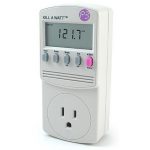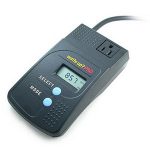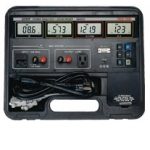Several readers have asked me how I measured the actual power usage of my test system in last weeks article on power supplies. It’s a simple process that I recommend every system builder undertake at least once to get a first hand understanding of the power requirements of their systems.
Here is a quick little step by step on how I did it:
- Go to your local hardware store and ask for a power meter.
- Plug the power meter into your wall outlet and switch the display to show ‘watts’.
- Plug the power cable from your computer (or your power bar if you want to measure system, monitor and peripherals) into the power meter.
- Boot up your computer and start running a combination of CPU and GPU benchmarks simultaneously (I ran Prime95 and 3DMark06).
- The LCD display on the power meter will show exactly how many watts of power your system is drawing from the wall.
There you have it. Five simple steps that will save you money and space when it comes time to build your next computer.
There are other options for power meters with varying levels of complexity. The power meter from UPM that I used offers all the information I needed at a decent price. Here’s a list of a few other units that will also do the trick:
 Kill-A-Watt ($25. thinkgeek.com)
Kill-A-Watt ($25. thinkgeek.com)
Similar to the UPM model, the Kill-A-Watt meter plugs into your wall outlet and monitors power consumption and displays it in real time. And it has a cool name.
 Watts Up Pro ($130. thinkgeek.com)
Watts Up Pro ($130. thinkgeek.com)
The more expensive models not only display real-time power use, but are also capable of logging your usage over a period of time allowing you to transfer the data to your computer for deeper analysis.
 Extech 380803 Power Analyzer Datalogger ($750. extech.com)
Extech 380803 Power Analyzer Datalogger ($750. extech.com)
This beastie is the weapon of choice for the gurus over at tomshardware.com. Probably not what you’re looking for, but if you are the type of person that just wants the best, look no further.
These are just a few of the many handy products out there to help you get an understanding of how much power your electronic devices use.
Don’t stop with your computer. Plug everything you can into your power meter (one thing at a time, of course) and you’ll be surprised at how much power some things use, especially when they’re turned OFF!
